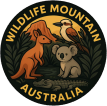GOULD'S LONG-EARED BAT
Gould’s Long-eared Bat – The Night’s Silent Hunter
Let us step quietly into the Australian night, where the air is still and the moonlight spills like silver across the forest canopy. In the shadows, a small winged figure stirs — a Gould’s long-eared bat, one of nature’s most skilled aerial hunters.
Appearance and Special Features
Measuring just 5–6 cm in body length, with a wingspan of up to 28 cm, this bat may seem unassuming at first glance. But its most striking feature is impossible to miss — ears nearly as long as its head. These remarkable ears are not simply ornamental; they are exquisitely tuned instruments. In the dark, where vision fails, they transform the bat’s world into a three-dimensional soundscape through echolocation.
Its fur is a soft, warm brown, blending seamlessly with the rough bark of eucalypts and the muted tones of woodland trees. This natural camouflage makes the bat nearly invisible during daylight roosting.
Gould’s long-eared bat takes its name from John Gould, a celebrated English naturalist whose work in the 19th century helped bring global attention to Australia’s unique wildlife.
Habitat and Range
This adaptable species can be found across eastern and south-eastern Australia, from Queensland through New South Wales, Victoria, and into parts of South Australia.
Their preferred habitats include:
- Woodlands rich with flowering plants and insect life
- Forests with dense understorey vegetation
- Urban green spaces such as gardens and parks, where they take advantage of artificial lights that attract insects
This flexibility allows them to survive in both wild and human-altered landscapes.
Hunting and Echolocation
As night falls, the Gould’s long-eared bat takes to the air in search of food. It is an insectivore, feasting on:
- Moths
- Beetles
- Various flying insects
Its long ears give it a distinct advantage. While many bats detect prey by the echoes of their own calls, Nyctophilus gouldi can also pick up the faint rustle of an insect’s wings. This allows it to hunt in near silence, a stealth technique especially effective in dense vegetation where echoes may be confusing.
Its echolocation calls are pitched far above the range of human hearing. When translated through a bat detector, they become a rapid series of clicks and chirps, each one a pulse of sound bouncing back with information about the world ahead.
Life Cycle
- Breeding season: Spring
- Young: Usually 1–2 pups born late spring to early summer
- Newborns: Hairless, blind, and completely dependent on their mother
- Independence: Within a few months, the young can fly and hunt on their own
- Lifespan: Up to 10 years in the wild, though many face early challenges from predators and habitat loss
Role in the Ecosystem
Gould’s long-eared bats are silent guardians of the night, helping to keep insect populations in balance. By consuming large numbers of moths and beetles, they protect both native plants and agricultural crops from overgrazing by insect pests.
Conservation Status and Threats
The species is currently classified as Least Concern, but that does not mean it is free from danger. Its greatest threats come from:
- Habitat destruction through land clearing
- Fragmentation of forests and woodlands
- Urban expansion reducing roosting and feeding grounds
Conservation efforts aim to protect and restore natural habitats, ensuring that these bats have safe roosting sites and abundant foraging areas.
A Final Reflection
If you could stand in a moonlit clearing and listen with a bat detector, you would hear the rapid, intricate chatter of a Gould’s long-eared bat sweeping overhead — a hunter moving unseen, yet tirelessly at work. Its presence reminds us that even the smallest creatures hold great importance in maintaining the delicate web of life.
Protecting species like Nyctophilus gouldi is not just about saving one animal — it is about preserving the harmony of entire ecosystems for future generations.

